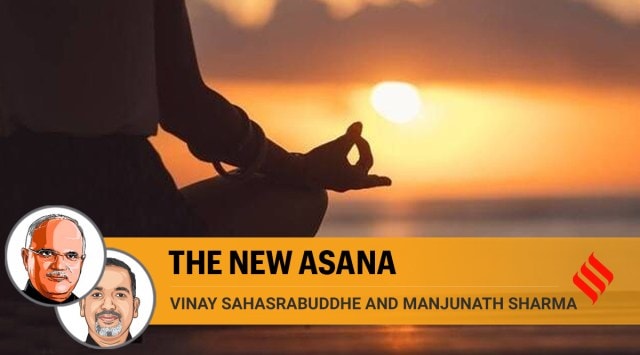World Yoga Day: Yoga’s challenge on the global stage
Vinay Sahasrabuddhe and Manjunath Sharma writes: With yoga spreading globally, the next task could be about protecting the purity of yoga and preventing trivialisation, adulteration and distortion of the science
 Yoga, apart from being a wellness strategy, has also facilitated the creation of start-ups focused on yoga accessories (such as apparels, mats, props, etc.) and yoga services (studios, therapy centres, lifestyle centres etc.).
Yoga, apart from being a wellness strategy, has also facilitated the creation of start-ups focused on yoga accessories (such as apparels, mats, props, etc.) and yoga services (studios, therapy centres, lifestyle centres etc.). This year the International Day of Yoga (IDY) being celebrated at the UN headquarters in New York with Prime Minister Narendra Modi in attendance, has a special significance. The IDY was essentially Modi’s idea. Nine years after June 21 was declared the International Day of Yoga, the IDY has been receiving a huge response. There is now greater awareness about the benefits of practising yoga for physical, mental, and emotional well-being.
Thanks to the IDY, yoga is now a global phenomenon. With the rise of social media and digital platforms, yoga has transcended geographical boundaries to reach people across the world. That 192 countries, including 44 Islamic countries, celebrated the first IDY in 2015 reveals its popularity. According to an informal assessment, over 400 million people participated in the 2022 IDY celebrations. The impact has been positive with a number of people in many countries practising yoga for wellness and health benefits.
The Indian Council for Cultural Relations (ICCR) and the Ministry of External Affairs with the support of AYUSH ministry have been promoting yoga. Since 2018, the ICCR has been organising an annual international conference aimed at creating a sound understanding of the holistic nature of yoga. This conference has also sought to trace the similarities between yoga and other traditional wellness practises in Africa and Southeast Asia. In general, the IDY has helped to demystify one of our precious knowledge traditions. As compared to the pre-2015 era, more people today know that yoga is not magic, religious ritual or gymnastics. The integrative and holistic approach central to the yogic science is now more intelligible than before. Yoga is more about practice and less about preaching. Most of those who practise yoga are seen to be engaging in experiential advocacy of yoga, something that has helped this science make deeper inroads worldwide.
No one can dismiss yoga as a sham anymore. The World Health Organisation in collaboration with the Ministry of AYUSH and major yoga institutions, has developed a new mobile app (mYoga) to educate people about the therapeutic benefits of yoga. The IDY has also helped to promote research in yoga. Research has established that the regular practice of yoga can help reduce stress, improve flexibility and balance, and lead to better physical and mental health. Many countries have incorporated yoga into their healthcare systems. The WHO has now initiated the process of developing a benchmark document for standards in yoga training.
After IDY 2015, the Government of India established 150 Swami Vivekanand District Yoga Health Centres and 1,25,000 AYUSH Health & Wellness Centres. Yoga therapy has become popular for post-Covid rehabilitation. The department of AYUSH in collaboration with NIMHANS and S-VYASA University has developed a Tele Yoga Advisory. Six central universities have started full-fledged departments of yoga. Over 30 per cent of private, state and deemed universities have started either a certificate, diploma or UG/PG programmes in yoga, since 2015. The first full-fledged yoga university — Vivekananda Yoga University, California — started a master’s programme in 2019. Three more American universities have started master’s programmes in yoga. Yunnan Minzu University, Kunming (China), SOAS, University of London, International College of Queensland (Australia) have also started such academic initiatives.
Notably, the IDY has popularised yogasanas as probable components of a competitive sport. For the first time, yogasanas have been included as a sport in Khelo India as well as the National Games. Also, India has rightly taken the lead in establishing National Yogasana Sport Federation and World Yogasana Federation, which are going to standardise and introduce yogasana-based competitions at national and international levels.
The IDY has opened up the world of yoga to a wider global audience. From the proliferation of new studios and teachers to the development of innovative products and services, the IDY has sparked a wave of creativity and growth. To strengthen good industrial practices, the Bureau of Indian Standards under the Ministry of Consumer Affairs also initiated the process of creating standards for yoga accessories. The accessories used for yoga cleansing techniques such as jala neti and sutra neti (nasal cleansing techniques) have been put through a standardisation process for future industrial use.
Yoga, apart from being a wellness strategy, has also facilitated the creation of start-ups focused on yoga accessories (such as apparels, mats, props, etc.) and yoga services (studios, therapy centres, lifestyle centres etc.). With the global yoga industry revenues crossing $100 billion, yoga-based start-ups are expected to increase significantly in the next one decade. Meditation-based mobile applications, specialised yoga mats, specialty yoga therapy and integrative medicine centres/Mind Body Medicine centres within conventional medical hospitals also have gone up substantially. Vivekananda Health Global, a chain of integrative medicine clinics that began as a startup in Bengaluru, has gone global with branches in China, South Korea, Singapore and the US. Multiple fitness chains have added yoga as a premium service and introduced yogic diet to combat lifestyle disorders.
In short, the IDY has helped create a sense of community among yoga practitioners and enthusiasts. With lifestyle issues posing health and wellness challenges, yoga could offer solutions derived from Indian traditional knowledge traditions. With yoga spreading globally, the next challenge could be about protecting the purity of yoga and preventing trivialisation, adulteration and distortion of the science.
Sahasrabuddhe is President, ICCR; Sharma teaches at S-VYASA University, Bengaluru








































